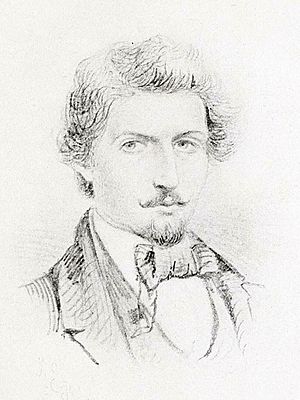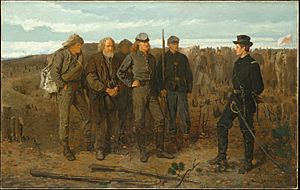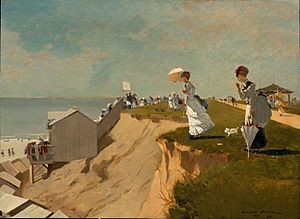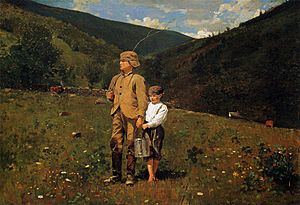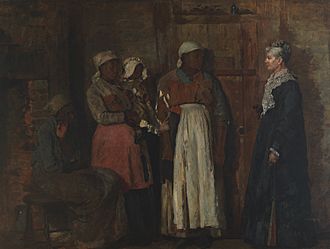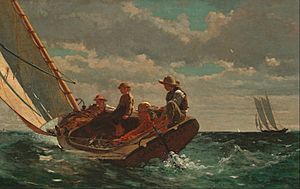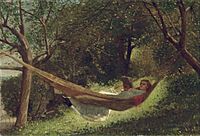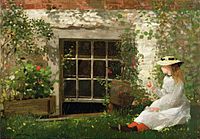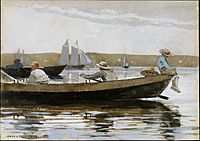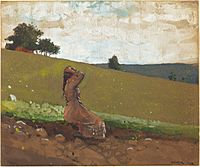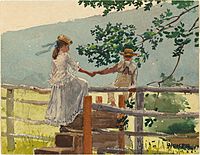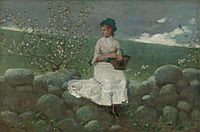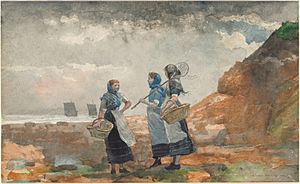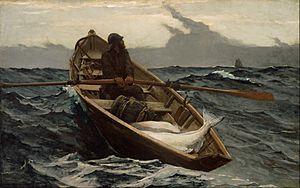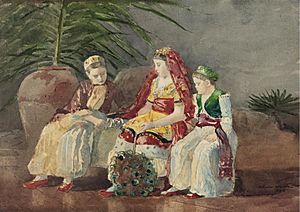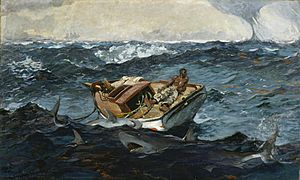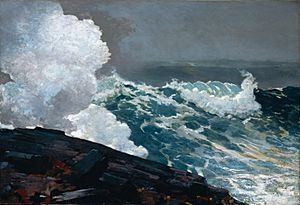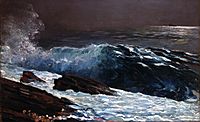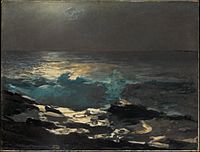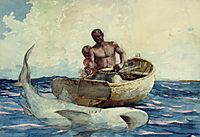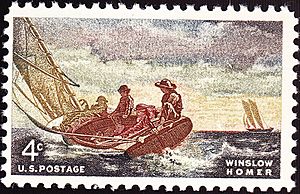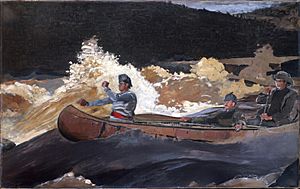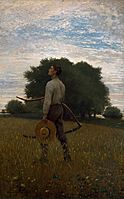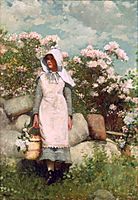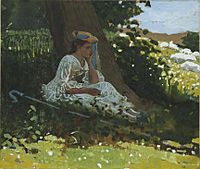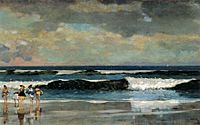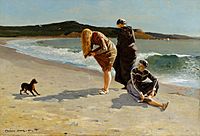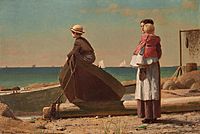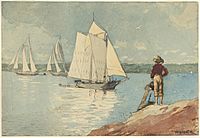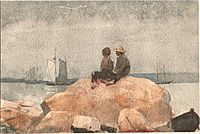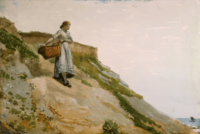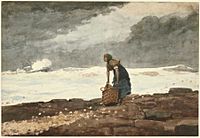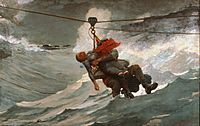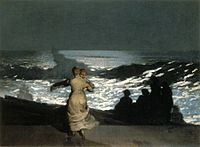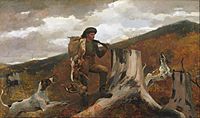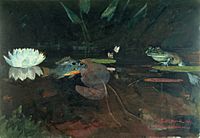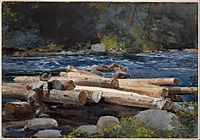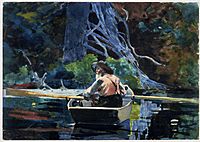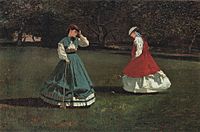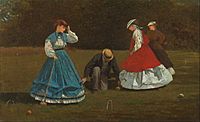Winslow Homer facts for kids
Quick facts for kids
Winslow Homer
|
|
|---|---|
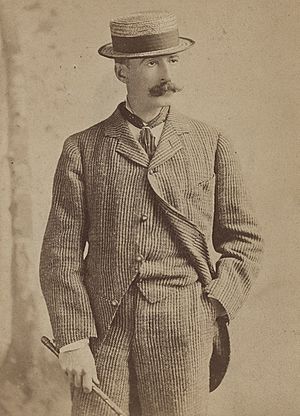
Winslow Homer in 1880, photo by Napoleon Sarony
|
|
| Born |
Winslow Homer
February 24, 1836 |
| Died | September 29, 1910 (aged 74) |
| Education | Lithography apprenticeship, 1855–56 National Academy of Design (painting), 1863 Paris, France (informal), 1867 |
| Known for | Drawing Wood engraving Oil painting Watercolor painting |
|
Notable work
|
Harper's Weekly Magazine Ballou's Pictorial Magazine Snap the Whip The Veteran in a New Field Breezing Up (A Fair Wind) |
| Movement | Realism, American Realism |
Winslow Homer (born February 24, 1836 – died September 29, 1910) was a famous American landscape painter and illustrator. He is best known for his paintings of the sea. Many people think he was one of the most important American painters of the 1800s.
Homer mostly taught himself how to paint. He started his career drawing pictures for magazines. Later, he began using oil paints to create large, detailed artworks. He also used watercolors a lot, making many bright and lively paintings, often about his trips and holidays.
Contents
Homer's Early Life and Art Training
Winslow Homer was born in Boston, Massachusetts, in 1836. He was the second of three sons. His mother, Henrietta Benson Homer, was a talented amateur watercolor artist and was his first teacher. Winslow and his mother were very close. He learned many things from her, including her quiet, strong-willed nature and her artistic talent.
Homer had a happy childhood, mostly growing up in Cambridge, Massachusetts, which was more rural back then. He was an average student, but his artistic skills were clear from a young age.
When Homer was 19, he started an apprenticeship with J. H. Bufford, a lithographer in Boston. This meant he learned how to make prints for commercial use. He spent two years doing repetitive work, like drawing covers for sheet music. In 1857, he decided to work for himself instead of joining Harper's Weekly full-time. He later said, "From the time I took my nose off that lithographic stone, I have had no master, and never shall have any." Homer then opened his own art studio in Boston.
Homer worked as an illustrator for almost 20 years. He drew pictures of city life in Boston and country life in New England for magazines like Ballou's Pictorial and Harper's Weekly. His early drawings were often wood engravings of social scenes. They had clear outlines, simple shapes, strong contrasts of light and dark, and lively groups of people. These qualities stayed important in his art throughout his career.
Before moving to New York in 1859, Homer lived with his family in Belmont, Massachusetts. His uncle's house, the Homer House, inspired many of his early drawings and paintings, including some of his croquet pictures from the 1860s. Today, the Homer House is open for public tours.
Homer's New York Studio and Civil War Art
In 1859, Winslow Homer opened a studio in the Tenth Street Studio Building in New York City. This city was a major center for art and publishing in the United States. He took classes at the National Academy of Design until 1863 and briefly studied painting with Frédéric Rondel. In just about a year of teaching himself, Homer was already creating excellent oil paintings.
Harper's Weekly sent Homer to the front lines of the American Civil War (1861–1865). There, he sketched battle scenes and daily camp life. He drew both the quiet moments and the chaotic ones. His first sketches were of Major General George B. McClellan's army near the Potomac River in October 1861.
These drawings helped Homer grow from an illustrator to a painter. He also drew women during wartime, showing how the war affected people back home. The war work was dangerous and tiring. Back in his studio, Homer would rest and then focus on his art. He created a series of war-related paintings based on his sketches. These included Sharpshooter on Picket Duty (1862), Home, Sweet Home (1863), and Prisoners from the Front (1866). He showed these paintings every year at the National Academy of Design from 1863 to 1866. Home, Sweet Home was especially praised by critics. It sold quickly, and Homer was elected a full Academician in 1865.
After the war, Homer mostly painted scenes of childhood and young women. These paintings often showed a feeling of nostalgia, meaning a longing for simpler times, both for himself and for the country.
Homer also painted about the quiet tension between different groups of people after the war. His oil painting A Visit from the Old Mistress (1876) shows a meeting between four formerly enslaved people and their old mistress. The way the figures are arranged suggests the balance the nation hoped to find during the difficult years of Reconstruction. Homer made this painting from sketches he drew while traveling through Virginia.
Early in his painting career, Homer, at 27 years old, showed great skill and understanding. His realistic style was honest, true to nature, and controlled in its emotions. One critic wrote that Homer was one of the few young artists who made a strong impression with their very first paintings.
Early Landscapes and Watercolors
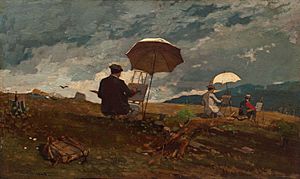
Before showing his art at the National Academy of Design, Homer traveled to Paris, France, in 1867. He stayed there for a year. His famous painting, Prisoners from the Front, was also on display in Paris at the same time. He didn't formally study art there. Instead, he practiced landscape painting and continued to work for Harper's, drawing scenes of Parisian life.
Homer painted about a dozen small paintings during his time in France. Even though new art styles were popular in France, Homer mostly painted scenes of peasant life. This showed he was more aligned with older French artists like Jean-François Millet than with newer artists like Édouard Manet. Homer was very private about his life and how he worked. He believed artists should "never look at pictures" but should "stutter in a language of their own." This meant he wanted artists to develop their own unique style.
Throughout the 1870s, Homer continued to paint mostly rural scenes. These included farm life, children playing, and young adults spending time together. Examples are Country School (1871) and The Morning Bell (1872). In 1875, Homer stopped working as a commercial illustrator. He decided to make a living only from his paintings and watercolors. Even though critics liked his work, he still struggled financially.
His popular 1872 painting Snap the Whip was shown at the 1876 Centennial Exposition in Philadelphia, Pennsylvania. One of his best and most famous paintings, Breezing Up (1876), was also there.
Breezing Up, which shows a father and three boys sailing, received a lot of praise. The New York Tribune newspaper said, "There is no picture in this exhibition... that can be named alongside this." Around 1876, visits to Petersburg, Virginia, led to paintings of rural African American life. Homer's honest style allowed him to create simple, powerful views of African American life at the time, like Dressing for the Carnival (1877) and A Visit from the Old Mistress (1876).
In 1877, Homer showed his oil painting, An Afternoon Sun, at the Boston Art Club for the first time. He often exhibited at the Boston Art Club until 1909. He also frequently showed his drawings and watercolors starting in 1882.
Homer became a member of The Tile Club, a group of artists and writers. They met often to share ideas and go on painting trips. Homer's nickname in the club was "The Obtuse Bard." Other famous members included painters William Merritt Chase and Arthur Quartley.
Homer began painting with watercolors regularly in 1873. This was during a summer stay in Gloucester, Massachusetts. From the start, his technique was natural and confident. His use of watercolors was groundbreaking. At first, critics were confused, with one saying Homer "made a sudden and desperate plunge into water color painting." But his watercolors became popular and sold well, greatly improving his financial situation. They ranged from very detailed (Blackboard – 1877) to more impressionistic (Schooner at Sunset – 1880). Some watercolors were practice sketches for oil paintings, while others were finished artworks themselves. After this, he rarely traveled without paper, brushes, and water-based paints.
In the late 1870s, Homer became more private. He no longer enjoyed city social life and instead lived in Gloucester. For a while, he even lived in the secluded Eastern Point Lighthouse. By observing fishermen, the sea, and marine weather, Homer found many new ideas for his art. After 1880, he rarely painted women at leisure. Instead, he focused on women who were working.
- Early landscapes and watercolors
Time in the United Kingdom
Homer spent two years (1881–1882) in the small fishing village of Cullercoats, Northumberland, in England. Many of his paintings from Cullercoats showed working men and women. These artworks had a new seriousness and strength, hinting at the direction his future art would take. He wrote, "The women are the working bees. Stout hardy creatures." Most of his works from this time were watercolors. His colors became more limited and serious. His paintings became larger, more ambitious, and more carefully planned. His subjects became more universal, focusing on heroic everyday life. This period helped Homer find a new style and vision for his art.
Life in Maine and Later Works
When Homer returned to the U.S. in November 1882, he showed his English watercolors in New York. Critics immediately noticed the change in his style. They said he was "a very different Homer" and that his pictures were now "works of High Art." Homer's paintings of women were no longer just pretty figures. They were now "sturdy, fearless, fit wives and mothers of men" who could bravely face nature's power alongside their men.
In 1883, Homer moved to Prouts Neck, Maine, in Scarborough, Maine. He lived in his family's remodeled carriage house, which was very close to the ocean. For the rest of the mid-1880s, Homer painted his impressive sea scenes. In Undertow (1886), which shows two lifeguards rescuing two female swimmers, Homer's figures look strong and powerful. In Eight Bells (1886), two sailors calmly check their position on deck. They are confident in their sailing skills but also respect the powerful sea. Other famous paintings from this time that show struggles with nature include Banks Fisherman, The Gulf Stream, and Searchlight on Harbor Entrance, Santiago de Cuba.
By age 50, Homer had become a bit of a "hermit with a brush," living quietly on his "art island." These paintings made Homer famous as "the most original and one of the strongest of American painters." However, even with critical praise, his work wasn't as popular as some other artists' paintings. Many of his sea pictures took years to sell.
In the winters of 1884–85, Homer traveled to warmer places like Florida, Cuba, and the Bahamas. He created a series of watercolors for Century Magazine. He replaced the stormy green seas of Prouts Neck with the bright blue skies of the Caribbean. He also painted Black local people instead of New Englanders. This helped him develop his watercolor technique even further. During one trip, he painted Children Under a Palm Tree.
A Garden in Nassau (1885) is a great example of these watercolors. Critics praised his fresh and original style, but traditional art buyers didn't always understand it. Homer lived simply, and his wealthy brother Charles helped him financially when needed.
Homer often visited Key West, Florida, between 1888 and 1903. Some of his most famous works, like A Norther, Key West, The Gulf Stream, and Palms in the Storm, are believed to have been painted there.
Homer also found inspiration during summer trips to the North Woods Club in the Adirondack Mountains of New York. On these fishing vacations, he experimented with watercolors. He created powerful and subtle works that celebrated nature and outdoor life. Homer's achievements as a watercolor artist are considered unmatched.
In 1893, Homer painted one of his most famous works, The Fox Hunt. It shows hungry crows attacking a fox stuck in deep snow. This was Homer's largest painting. It was quickly bought by the Pennsylvania Academy of the Fine Arts, becoming his first painting in a major American museum collection. Another late work, The Gulf Stream (1899), shows a Black sailor alone in a damaged boat, surrounded by sharks and a coming storm.
By 1900, Homer finally became financially stable. His paintings sold for good prices to museums, and he earned money from real estate. He continued to create excellent watercolors, mostly during trips to Canada and the Caribbean. Other late works include hunting scenes like Right and Left, and seascapes without people, often showing waves crashing against rocks. His late seascapes are especially valued for showing the dramatic power and beauty of nature.
Winslow Homer died in 1910 at age 74 in his Prouts Neck studio. He was buried in the Mount Auburn Cemetery in Cambridge, Massachusetts. His painting, Shooting the Rapids, Saguenay River, was not finished.
His studio in Prouts Neck, which is a National Historic Landmark, is now owned by the Portland Museum of Art. They offer tours for visitors.
-
Sunlight on the Coast, 1890
(Toledo Museum of Art, Ohio)
Homer's Influence on Art
Winslow Homer never taught art in a school or privately. However, his artworks greatly influenced later American painters. His paintings showed a direct and strong way of looking at how humans relate to nature, which can be harsh or neutral. Artist Robert Henri called Homer's work an "integrity of nature."
American illustrator and teacher Howard Pyle admired Homer. He encouraged his students to study Homer's art. His student, N. C. Wyeth, and through him, Andrew Wyeth and Jamie Wyeth, also felt Homer's influence. N. C. Wyeth's respect for Homer was "intense and absolute." You can see this in his early work Mowing (1907). Perhaps Homer's strong belief in working independently is best shown in his advice to artists: "Look at nature, work independently, and solve your own problems."
Winslow Homer on U.S. Stamps
In 1962, the U.S. Post Office released a commemorative stamp to honor Winslow Homer. Homer's famous oil painting Breezing Up, which is in the National Gallery in Washington D.C., was chosen for the stamp's design.
On August 12, 2010, the Postal Service issued another 44-cent commemorative stamp. It featured Homer's Boys in a Pasture. This stamp was the ninth in a series called "American Treasures." The original painting is at the Museum of Fine Arts in Boston. It shows two boys from Belmont, Massachusetts, named John Carney and Patrick Keenan. They posed for the artist for 75 cents a day.
Winslow Homer's Artworks
Winslow Homer was known for working in many different art mediums. He was prominent in various types of art, as shown in the examples below:
- Country life
Pastoral landscapes are a type of art that shows shepherds herding animals in open, natural areas. These scenes often change with the seasons and where water and grass are available.
- Pastoral landscapes
Winslow Homer's paintings often showed marine landscapes, meaning scenes of the sea. Later, when he lived in the village of Cullercoats, England, from 1881 to 1882, his paintings of shores and coastal areas changed. Many of his paintings from the English coast featured working men and women from that area.
- Shores and beaches
- Mountain landscapes
- Croquet
See also
 In Spanish: Winslow Homer para niños
In Spanish: Winslow Homer para niños


